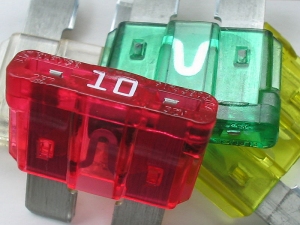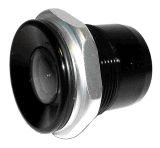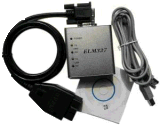Carputer Wiring
Carputer wiring is an area which is often dismissed from consideration. It is a simple job, but there are still important decisions to be made if you want to do the job correctly. Firstly, all wire has resistance. Electrical resistance is the opposition to the flow of electric current through a conductor. The unit of measurement is the Ohm (Ω) and in a DC circuit, it can be calculated by dividing the voltage by the current flowing.
The value of the resistance depends upon the material from which the wire is made and the cross-sectional area of the conductor. Electricity flowing through a wire is often compared to water flowing through a pipe. If we consider the water pipe analogy, the larger the bore the less resistance there is to flow and the greater the amount of water flowing through the pipe for a given pressure. In a wire, the value of the resistance depends partly upon the material from which the wire is made but also on the cross-sectional area of the conductor. So in the same way as a larger diameter pipe allows more water to flow for a given pressure, a thicker wire has a lower resistance and will allow more current to flow for a given voltage. (You can think of voltage as electrical pressure).
You should also expect to use a different type of wire to provide power, from that which you use for audio and video signals.
Carputer Wiring - Power
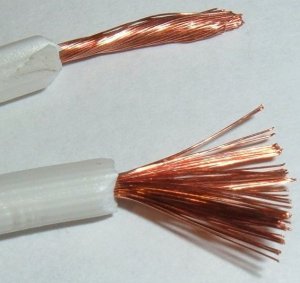
Let's deal with the power wire first of all. This is generally an inner core of copper (the conductor), with an outer plastic sheath which acts as an insulator. Wire can have a solid core, or can be made up of many thin strands twisted together to make up a much thicker conductor. The core may be purely copper or "tinned" i.e. coated on the outside with a thin layer of solder. For carputer wiring, you should use stranded wire because it is more flexible and tolerant of the vibrations and shocks which are common in an automotive environment.
There are also different tpes of insulation used to cover the conductors. Wire for automotive applications can be exposed to some pretty harsh conditions. Looking at all areas of the vehicle, the temperature extremes can range from -40°C to 60°C and typical environmental exposures include water (fresh and salt), snow and ice, mud, road salt, oil and grease, petrol (gasoline) and diesel. These factors need to be considered when selecting the wire, although it is highly unlikely that all of these conditions would apply to a single installation.
Make sure you buy automotive wire for your DIY carputer wiring and when running the power to your carputer, I recommend you get twin core wire and run both positve and negative wires directly from the battery (suitably fused of course). For a single car, you should be able to find a supplier who will sell you the wire cut to the length you need. This is cheaper than buying a reel of cable, but the price per unit length may be double what you would pay for that reel. If you see yourself doing this again, in cars you haven't even started to think about yet, buy a reel.
Use Table 1 below to establish the gauge of wire you need to power your carputer installation. Do not skimp on the wire you use. You want to be sure it is capable of supplying the necessary power. If you intend to also fit an audio amplifier, remember to take into account the current this will draw. If you are going to the trouble of running a supply from the battery, you want to be sure it can supply every item you intend to install.
Wire sizes are normally shown as either A.W.G. (American Wire Gauge) or metric sizes. Table 2 gives a comparison between AWG sizes and their metric equivalents.
To use table 1, read down the second column from the left until you get to a value which matches the maximum power which will be used. If your power value is not shown, round up to the next figure. Select this row. Read along the top row until you get to a cell which matches the length of cable run. Remember to include the length of both the supply and return wires. Again, round up if necessary. Select this column. The gauge you need for your carputer wiring is the figure in the cell where the row and column you have selected intersect.
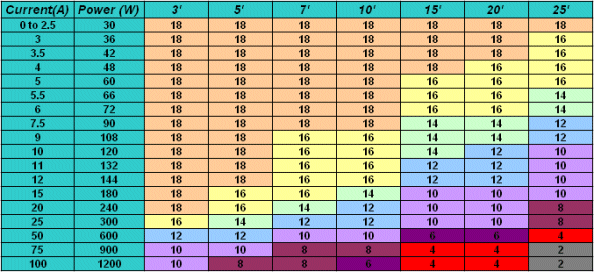 |
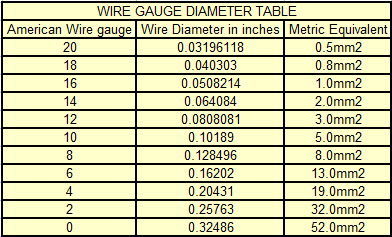
Carputer Wiring - Audio.
As with any wire, thicker more expensive wires will have lower resistance, but don't pay through the nose for expensive oxygen-free speaker cables (unless you are a complete audio perfectionist). After all, the inside of a moving car is not a perfect listening environment. Similarly, unless you have an issue with interference, gold plated connectors are not necessary for this application. The best way to avoid interference is to keep your audio cable runs as short as possible, and route them away from power cables where you can. For speakers up to 50W, 1mm² (16 AWG) twin core speaker wire will be fine. If you have a higher powered subwoofer, 3mm² (12 AWG) wire will be sufficient to handle up to 100W.
Auto Fuses - what you need to know.
Car Batteries
Display Screens
Memory
Motherboards and Processors
Optical Drives
« Return from CARPUTER WIRING to WIRING TIPS
my-car-computer.com
